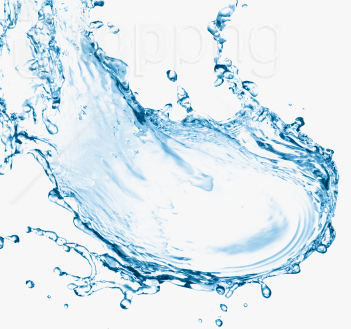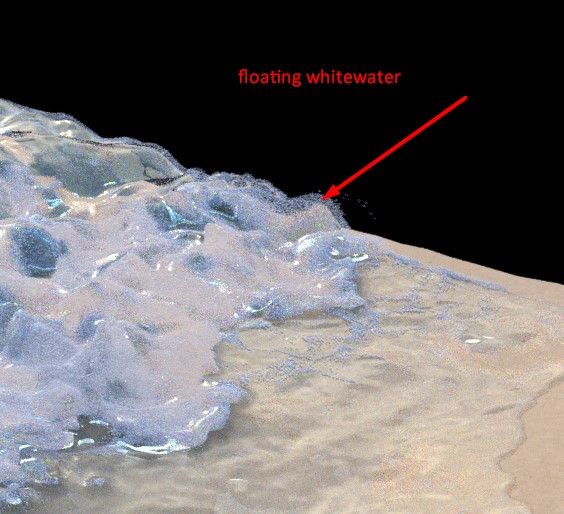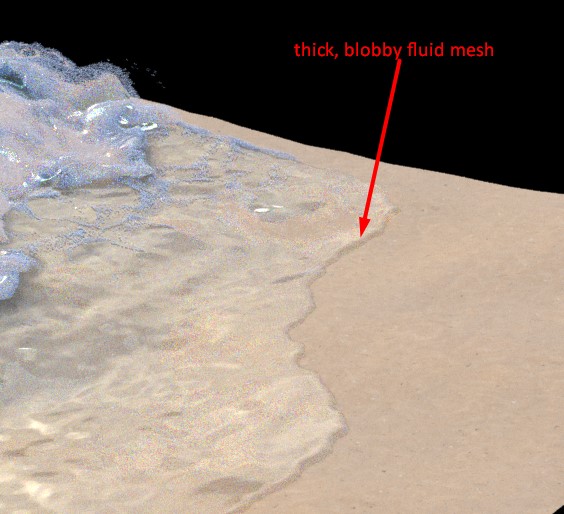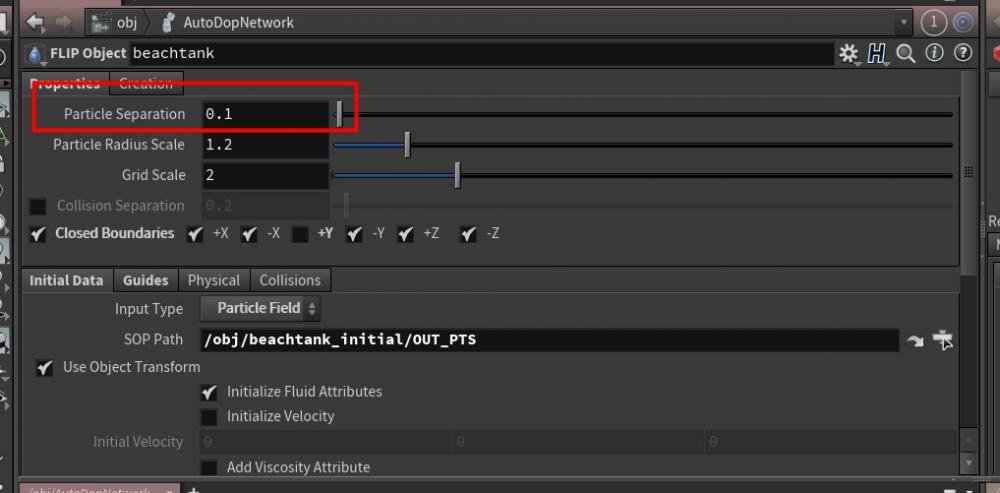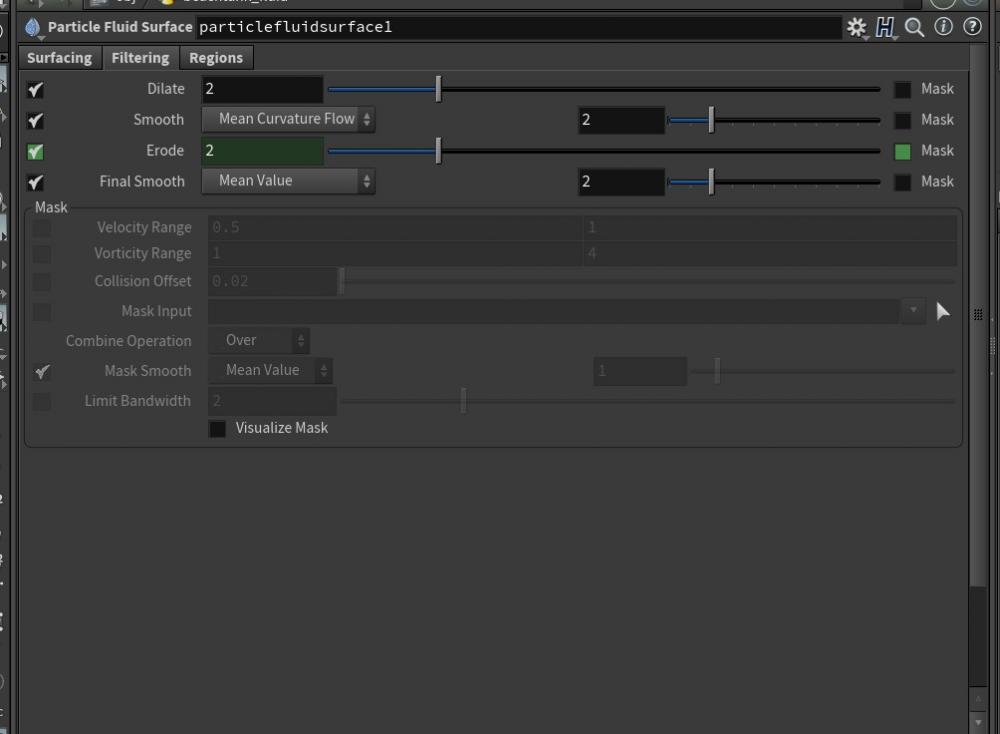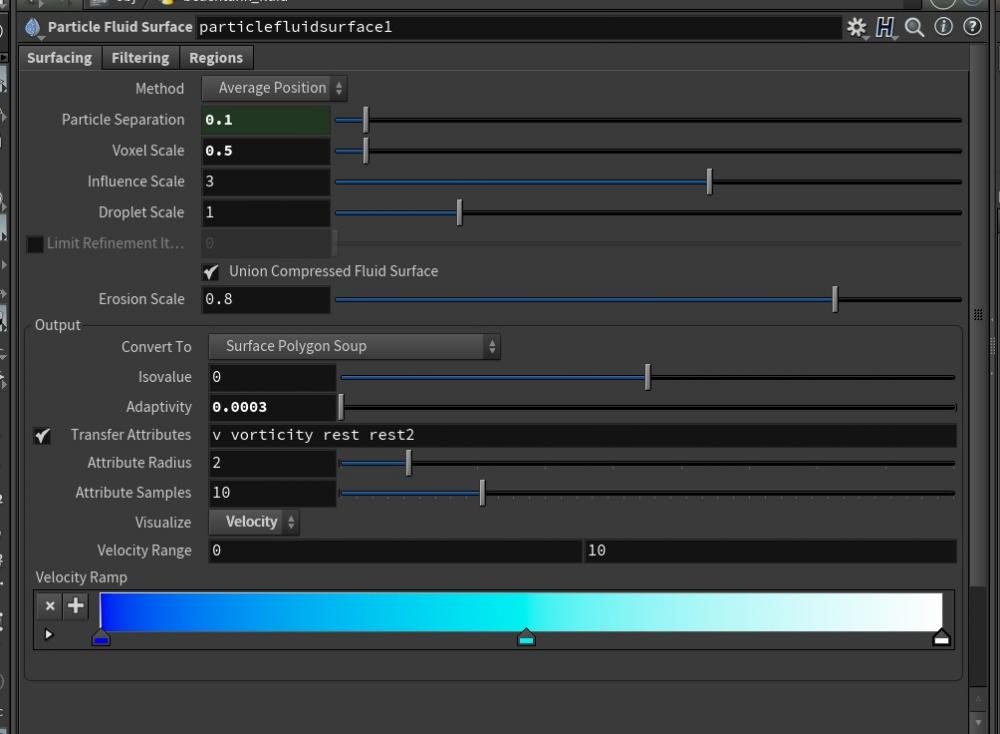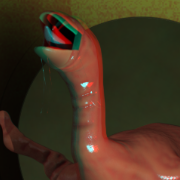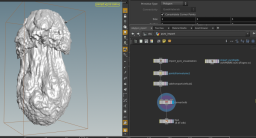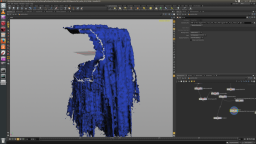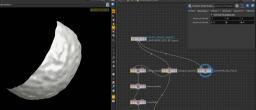Search the Community
Showing results for tags 'meshing'.
-
Dear ODForce krew, I am doing a bullet through a fish tank in slow mo. I have simmed only a chunk of the water for two reasons. First so I can have more resolution, and second as most of the tank would not be affected by the bullet, saving unnecessary sim time. I also have a procedural cuboid with ripples (frozen of course at this time scale), that becomes the rest of the water). Where the water is coming out (having chopped the FLIP mesh and cuboid down the middle) I can boolean them together, SORTED. However the other side where the water is going in I cannot figure out an operation to leave me with the cuboid's face and the indented water of the FLIP mesh. Any ideas or knowhow? Thanks in advance, 5D. NB: The cuboid is also essential around the parts of the tank that are not being affected by the glass because the interface of the glass and the water needs to be perfectly smooth, as if I use FLIP there and surface it no matter the smoothing it's not totally flat. NB2: Here's a pic of the glass shatter to help anyone understand what is going on.
-
Hello guys, i using the Particle Fluid Surface SOP to build the mesh of the simulation, however i need the increase the volume of mesh just at bottom of the model. i find the mask options quite usefull doing that job when i place the geometry to use as mask, the entire simulation mesh gets dilated and where is the geometry still same size (its inverted) i trying to set the dilate thing just inside the mask, but with no luck yet. thanks in advance. ps: i uploaded an basic .hip scene flrip_mesh_masl.hipnc
-
Hello! I am new to FLIP fluids simulation in Houdini and I found that FLIP fluids behaviuor totally changes depending on particle separation parameter. If I make more particles I am getting different shapes. In this Example I am trying to make a fluid splash in different directions. I am setting initial particle velocities by attribute transfer from geometry. And for example I like a shape of splash when particle separation = 0.05, but I want to get a quality mesh with nice thin shapes and round droplets, and for this I need to simulate more particles. But if I'm changing particle separation to 0.03 I have a different shape, with many small droplets and with totally different splash shape. What is wrong in my workflow? How to make a clean mesh with thin shapes, round droplets, not look like a metaballs mesh. For a reference https://www.pngitem.com/pimgs/m/312-3122129_liquid-splash-png-transparent-png.png test_splash_v01.hipnc
-
Hi everyone, recently picked up HOUDINI, coming from 3ds max. loving HOUDINI and its workflow! been doing some experiment with white water + flip, and had a few questions. the scene is based on the whitewater shelf tool. i have been tweaking the settings to get more detail and a more realistic look. the scene is rendered with redshift, with some basic shaders, so please excuse the rough render. attached a short test render for reference. Q1, FLIP MESHING thickness? blobbiness. the FLIP particle looks good, but when i mesh them, feels like i am "loosing" quite a bit of particle details and the mesh always looks bit blobby and thick. i have tried adjusting [particle separation] parameter down to 0.1 to get more "detail" into the simulation itself, and it helps. however, still feel like the water feels too blobby, as shown below. is the only way to get the thinner flip mesh to go with add more particles? i had tried reducing @pscale and [droplet scale], which does produce "thinner" looking fluid, is this the right workflow? but once this parameter is tweaked with, the White water particles (more information below) seems to "float" above the water mesh. also tried adjusting [influence scale], reducing it seems to retain more "detail" on the fluid surface, but noisier, is the default value a good value at production? Q2 WHITE WATER particles floating on top of fluid Mesh. the white water particles seems to be floating above the mesh water line, i am assuming its because white water is calculated based on the FLIP particles, not mesh. where meshing seems to change in its volume based on filtering and other settings. is there any way of marrying them better? Q3 BEST METHOD RENDERING WHITE WATER with REDSHIFT I am currently rendering WHITE WATER as simple particles with motion blur. was wondering if this is best practice to render white water with redshift? for example, is it advisable to separate the WHITE WATER as a separate pass? and comp them in post? and any other general TIPS and feedback is appreciated. apologize regarding the long post, and thank you in advance for any suggestions! have a great day all! waveBB.mp4
- 2 replies
-
- flip
- white water
-
(and 1 more)
Tagged with:
-
Hi, I am importing an Alembic particle sequence from realflow. Shows up great in Houdini, no problems there. I want to 'mesh' it, I was thinking I would convert it to VDB and then to polys to have maximum control however the 'VDB from Particles' node is not taking the alembic particles (ie. nothing happens). Do I need to convert them to something else before? Am I approaching this completely wrong? Much obliged,
-
Hi ! I'm currently working on a vellum grain simulation for snow. I need to export it to Maya for the rendering process! (our light rig and texturing is made on Maya) So my idea was to separate my meshing in two parts: • one will be particles that moved at least one time (the real "grains") aka a dense meshing to get grains almost individually • the other will be the particles that did not move/are less important aka lighter meshing to get the shape of the grains. in these way, for big scenes, I'll have a two alembic low & high, instead of one very heavy alembic file. Problem is : I can't seems to find a way to separate the two of them. I saved my simulation (cache) with P and V , and wanted to create a group that'll update at every frames to put the new points that moved in it. Unfortunately: Houdini is overreding the group, like it's creating a new one for every frame. Any idea what I can do ? Thank you so much, Marine PS : On the file I attached, the idea is to get everything around the foot shape in red
-
I have a meshed FLIP sim (cached out, .bgeo files read back in) that I want to use as a "solid" object and have a rigid body rest on top of it (the idea is that something solid "ripples" psychedelically and the objects resting on top of it move as the ripples go underneath--but the original object is still a solid, and the objects don't sink into it). I just can't get it to hold up, however--when the RBD object is initially "dropped" onto the fluid mesh, it bounces and settles as expected, and does okay with simple early movement, but eventually the collisions become less and less precise and the RBD object just sort of sinks in. How can I get the mesh to read as just a run-of-the-mill deforming object? I've tried RBD solver, bullet solver (obviously doesn't work with the shape of the mesh), volume and surface collisions, jacking up collider volume resolution to make sure all the little waves are getting captured, and boosting the substeps, but the result has been pretty consistent (except more substeps = super jittery RBD as it's reading all of the little pre-big-movement mesh ripples). On the attached setup (a simpler version of the project giving me trouble) I even ran the meshed surface through a "clean" just in case any of the lingering velocity attributes were throwing it off, but that didn't help either. I'm wondering if the fact that the topology itself changes so much might be the problem, but if so I'm not sure how to fix that. Thanks for any suggestions! flipmeshtest.mp4 meshtest.hiplc
-
Hey guys, I have a little question regarding flip meshing. I'm trying to do some studies using the Particle Fluid Surface node for my final mesh, but I'm feeling something is a little bit off in my results Dunno if it's just the lack of refraction and shading, but my mesh seems a little blobby. I already tried to play with Voxel Scale, Influence Scale, and Droplet Scale, but in the end, it still a little blobby to me My flip sim is ok, good resolution, billions of particles and stuff. Any pro tips? PS: I've already tried the filtering options, masking, etc My mesh Same sim, but only points
-
Hi Guys, I try to simulate a quiet river. But I got the problem that in the areas where the water is not moving at all(or is really really slow), it is moving up and down all the time and looks like little hills. It is not flat what you would expect.I know it is possible to do with other programs but has anybody a solution for houdini ? I tried already the swirl kernel, a sop to settle down the y axis(based on velocity) and a blending with a simple grid based on the velocity. Is there an official way in the simulation process? I am thankful for any advice
-
Hi all. Can anyone tell me what the best method for bringing in ASCII data into Houdini would be. I have PTX point clouds that I would like to mesh in Houdini, but I can't load them. Here's an example of the first 20 lines from one of the PTX files: 3680 2463 7115.197796 14574.203673 51.118767 0.737771 -0.675051 0 0.675051 0.737771 0 0 0 1 0.737771 -0.675051 0 0 0.675051 0.737771 0 0 0 0 1 0 7115.197796 14574.203673 51.118767 1 0 0 0 0.500000 0 0 0 0 0 0 0.500000 0 0 0 0 0 0 0.500000 0 0 0 0 0 0 0.500000 0 0 0 0 0 0 0.500000 0 0 0 0 0 0 0.500000 0 0 0 0 0 0 0.500000 0 0 0 0 0 0 0.500000 0 0 0 0 0 0 0.500000 0 0 0 0 0 0 0.500000 0 0 0 Thanks!
-
hey! I'm doing a product splash with a slow mo effect. I tried different solutions about how to retime the sim, and I'm pretty happy at the moment with the technique of timeblend / tiemshift. I was also keen on trying the substep caching ( so a more accurate solution, but slow...) . Anyway, as I said I'm pretty happy with the sim, but once I mesh the particles it seems like the mesh is not really consistent across the frame. Is something you don't notice at full speed, but in slow mo is quite important, especially with water where even a little change in the mesh dramatically modify the look of reflections/refractions. So what I'm doing is cranking up the number of particles (reducing the separation...) to get a more precise mesh. But I'm paying this in terms of sim speed...I was wondering if any of you has experience in this topic. I'm also thinking about changing the scale of the scene, is quite big at the moment (geos are from another software), maybe simming this at a proper scale will help sim_v003_t000.mp4
-
Hi, Sorry if this was already covered (I found similar topics but on older versions of Houdini and I'm a newby). I would like to create a mesh (a sequence of mesh, to export in the obj format) from a pyro fluid (from smoke but also from density/heat and other elements). I've been trying with some methods by browsing online but without a great success. Considering that I need a classic mesh and not a VDB which would be the best workflow ? (pyrofields --> blast -> isooffset or --> points from volume --> vdb from particle --> convert to vdb) Best Alan
-
Hi all, Does anyone know how to use the mask input option to smooth a part of the mesh inside the particle fluid surface node? I want to specify with a volume (ie. a bounding box) which part of the mesh to smooth or keep (instead of using the velocity or vorticity mask). I created the volume to mask with (just a box turned to vdb) as a separate OBJ, I am then object merging it and connecting it to the third input of the fluid surface node, then in the filtering tab in mask input I check it and put in the name of the volume. I have tried to do several different things on the volume itself (regular VDB, Fog VFB, etc.) and nothing seems to work or make any difference. When I turn visualize mask on all it shows is nothing is applied to it (ie. all of the surface has 0 smoothing applied to it) How do I properly use this feature and get the node to recognize the mask? Am I going about this the right way? Many thanks, CrownSplash Anim C.hiplc
-
Hi, I am working with per point density and viscosity in a flip sim to get mud covered by water. So far everything works fine. Now when it comes to meshing I want to get two meshes out of the sim. One for the water and one for the mud to be able to see the mud through the semi transparent water. I get my groups (mud and water) via the dop I/O but are losing them in the fluid compress node with the packed particles. So the only way I can think of right now is to save the cache without the packed particles option ... making them pretty big I guess ... in order to get two seperate point groups and hence two meshes for the mud and water. Can anyone please help me how to go about this ? Or am I going the wrong direction anyway to see mud through the water. Cheers Rico Well I just realised that the packed particle option doesn't make a big difference in the cache size ... surprise ... i guess it is just for loading optimization?
-
Hey guys! I'm trying to mesh a FLIP sim but I encountered some issues with the holes in the geometry. Out of the 600 frames which I meshed only 1 frame has this tearing issue I have attached a screenshot of the tearing.Any help would be greatly appreciated!
-
- geometry tearing
- VDB
-
(and 2 more)
Tagged with:
-
Hello everyone, I was looking into the "new" way of meshing FLIP fluids - the VDB meshes.. It works like a charm and I like it a lot, but I miss one very important feature in there - if I want to mesh only a part of the particle "volume", with the old Particle fluid surface I could define a bounding box and all the meshing was done just and only in this bounds and without the "border sides" of the bounding box meshed.. I try to illustrate what I have in mind on the picture - there is a FLIP Fluid sphere, meshed with the Particle Fluid Surface with the bounding box enabled. Does anyone know how to set up a similar approach with VDBs? And if the bounding box could be another object (like a sphere, or anything), that would be even more great.. A simple hipfile would be VERY appretiated - it's the best way to learn - to be able to try out different settings and play with the scene...But of course any advice/explanation would be great. Thanks a lot!
-
Hi, Meshing particles or particle fluids using the new vdbfromparticlefluid SOP, I was wondering if it is possible to bake a displacement from a texture or procedural displacement into the mesh (Yes, I am well aware that might result in monsters). The stupid thing about it is I have no idea how to do this or where to look it up. Thank you very much in advance for any help or tips!!
-
Hi, Is there a way to only mesh the top surface of FLIP tank? Using VDB method? I mean apart from meshing the whole thing and delete the rest. That seem like wasting computing power. Thanks
-
Hi all, I'm in a bit of a pickle, and it'd be great if anyone can offer some insight on this. I have a FLIP sim being meshed with the new VDB meshing workflow, and I am getting a ringing pattern in the vdb sdf volume after the vdbsmoothsdf operation has been applied. I am trying to get rid of the ringing as it is passed onto the mesh resulting from convertvdb and ends up in the final render. The FLIP sim used a Particle Separation of 0.3 and resulted in ~1.3 million FLIP particles packed tightly in a 4x4x4 unit (meter) space with no open holes, etc. The VDB SDF Smooth operation uses Gaussian with filtering voxel radius = 2 and iterations = 4. This is meant to be a very smooth liquid--like hot chocolate. The results from other smooth methods (Laplacian Flow, etc) were not smooth enough. I have tried to increase the smooth radius and iterations, but it seems the more I increase these values the ringing gets worse. I also tried to set vdbfromparticle above vdbsmoothsdf to over-sample by reducing Voxel Size to 0.006 (instead of the default 0.3/2 = 0.15), and then turn up the smoothing. This made the ringing significantly finer, but the artifact still remains visible in the smoothed sdf. I'm sorry for posting all this details without a hip file. I will try to post an isolated example tomorrow as I only have the production file at the moment. But has anyone run into this problem in the past or is dealing with it right now? Thanks in advance for any help offered.

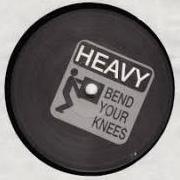
.thumb.png.215da6af24784c8657c64f95757729c2.png)
.thumb.png.686f0b08502d599d009e02a27ecf6d84.png)
.thumb.png.9c734b3a06fdf6b1d2ed380269ce323d.png)
.thumb.png.921f4322230ed5e0b78e445a3a68d39b.png)


